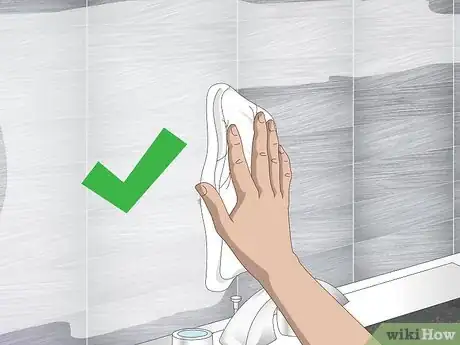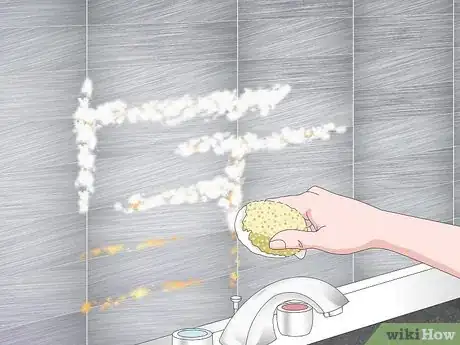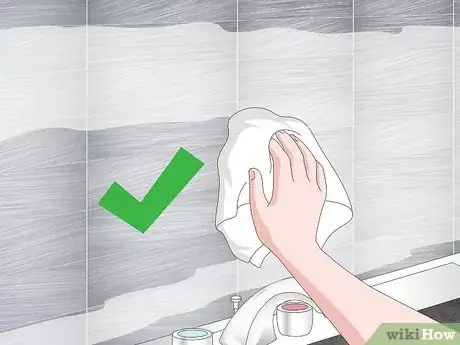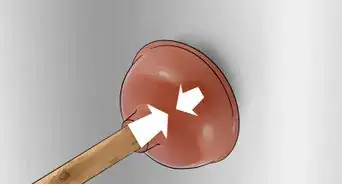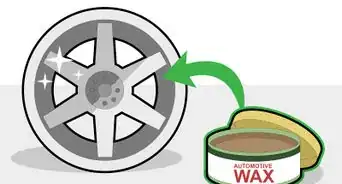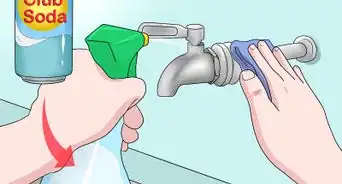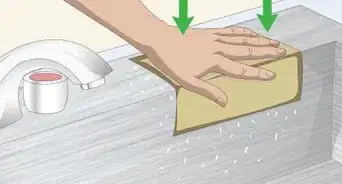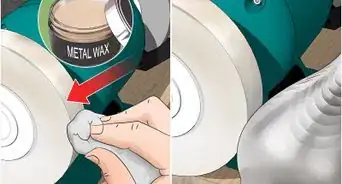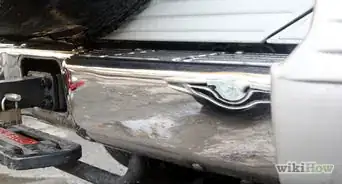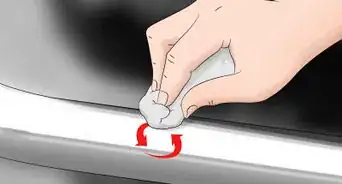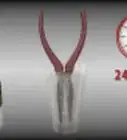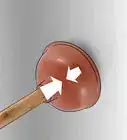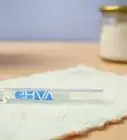This article was co-authored by Erik Bakirov. Erik Bakirov is a Cleaning Specialist at Room413 Cleaning in Los Angeles, California. Erik specializes in deep, move-in, and move-out cleaning services. Room413 matches homeowners with reliable and trustworthy cleaning services. They also promote environmentally friendly cleaning products.
This article has been viewed 34,321 times.
Metal backsplashes are appealing because they are so resistant to damage. Still, regular cleaning is useful to prevent ugly stains from setting. The first step is always to blot up the stain and wipe it off with plain water.[1] Tougher stains can be treated with soapy water, baking soda, or vinegar. When you are finished, rinse and dry the backsplash to make it look as good as new.
Steps
Cleaning General Stains
-
1Find the direction of the metal’s grain. Look closely at the metal backsplash. The metal particles may appear to move in a certain direction, such as side to side. If your backsplash has a noticeable grain, always scrub in the direction of it. This will prevent the metal from taking on tiny scratches.[2]
-
2Dampen a microfiber cloth in warm water.[3] Use a microfiber cloth or non-abrasive sponge. Metal brushes and scrub pads will scratch your backsplash, so avoid them. Warm water cleaning, when done routinely, limits the need for deeper cleaning. Never use hot water on the backsplash.[4]
- A mild detergent, such as a dish soap like Dawn or a non-chloride cleanser, can also be used for extra cleaning strength. Add a drop or two of the detergent to the water.[5]
Advertisement -
3Wipe off the stains with the cloth. Use the microfiber cloth to clean the backsplash.[6] Work in circular motions along the grain. Most of the time, the day’s stains will come right off. Older stains are likely to require deeper cleaning.[7]
- Never use scrub pads or wire brushes on the backsplash. These will scratch it.
-
4Dry the backsplash with a clean cloth. Get a dry cloth and use it to absorb the water on the metal. Although metal backsplashes are resistant to damage, hard water can weaken them. It’s better to dry the metal by hand so water doesn’t sit on it.[8]
Removing Stubborn Stains
-
1Combine baking soda and warm water in a bowl. Mix a cup (240 mL) of baking soda in a cup of warm water. Stir them together to form a paste.[9]
-
2Let the baking soda paste dry on the stain. Apply the paste to the stain using your cloth or sponge. Wait for the paste to dry. Take a clean, dry cloth and use it to wipe off the paste. Check to see if the stain has been removed.
-
3Combine vinegar and water in a spray bottle. Mix an equal amount of vinegar and warm water. Add them to a spray bottle if possible, since this will allow you to coat the stain with an even, controlled amount of the mixture.[10]
-
4Let the vinegar mixture sit on the stain for five minutes. Spray the mixture onto the stain. After five minutes, come back and prepare to finish treating the backsplash with a general wash..
-
5Wipe off the vinegar with a damp cloth. Dampen a soft cloth in warm water. Rub the cloth against the metal’s grain over the stained areas. Make sure all vinegar is removed.[11]
-
6Dry the backsplash with a clean cloth. Finish up by using a soft cloth to remove the water. Make sure no water is left or else it can damage the backsplash.
Maintaining Metal Backsplashes
-
1Blot stains immediately. Use paper towels to blot grease and remove food spatter. Removing stains as quickly as possible prevents them from setting. Acidic food such as tomato sauce or lemon juice can damage metal over time, so don’t let those stains linger.[12]
-
2Spray glass cleaner to remove fingerprints. Pick a non-chloride glass cleaner or all-surface cleaner such as Windex. Use it between washings to remove minor stains like fingerprints. Spray the cleaner across the surface of the metal. Wipe the fingerprints off with a cloth, then wipe up excess cleaner or allow it to air dry.[13]
-
3Buff the metal with olive oil. To give the backsplash a shine, add a tablespoon of olive oil to a soft cloth. Spend a few minutes rubbing in the oil along the grain. Leave the oil alone and it’ll protect your backsplash from stains for a few weeks.[14]
- Commercial metal polish can also be used, but olive oil works well and is less expensive. Other oils, including baby oil, may also work.
Things You’ll Need
- Paper towels
- Microfiber cloths or non-abrasive sponges
- Warm water
- Mild liquid detergent or non-chloride cleanser
- Baking soda
- Vinegar
- Bowl
- Spray bottle
References
- ↑ Erik Bakirov. Cleaning Specialist. Expert Interview. 7 January 2021.
- ↑ http://www.huffingtonpost.ca/2015/08/11/how-to-clean-stainless-steel_n_7972044.html
- ↑ Erik Bakirov. Cleaning Specialist. Expert Interview. 7 January 2021.
- ↑ http://www.decoist.com/2014-04-11/how-to-clean-stainless-steel/
- ↑ http://www.decoist.com/2014-04-11/how-to-clean-stainless-steel/
- ↑ Erik Bakirov. Cleaning Specialist. Expert Interview. 7 January 2021.
- ↑ http://www.homedit.com/stainless-steel-backsplashes/
- ↑ Erik Bakirov. Cleaning Specialist. Expert Interview. 7 January 2021.
- ↑ http://www.thekitchn.com/how-to-clean-greasy-kitchen-walls-backsplashes-and-cupboards-229508
- ↑ http://www.decoist.com/2014-04-11/how-to-clean-stainless-steel/
- ↑ http://www.thekitchn.com/how-to-clean-greasy-kitchen-walls-backsplashes-and-cupboards-229508
- ↑ http://www.thekitchn.com/how-to-clean-greasy-kitchen-walls-backsplashes-and-cupboards-229508
- ↑ http://www.homedit.com/stainless-steel-backsplashes/
- ↑ http://www.decoist.com/2014-04-11/how-to-clean-stainless-steel/




